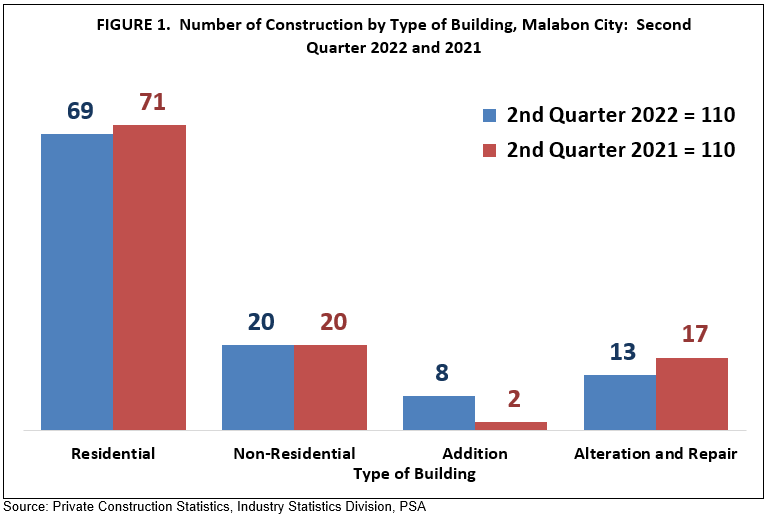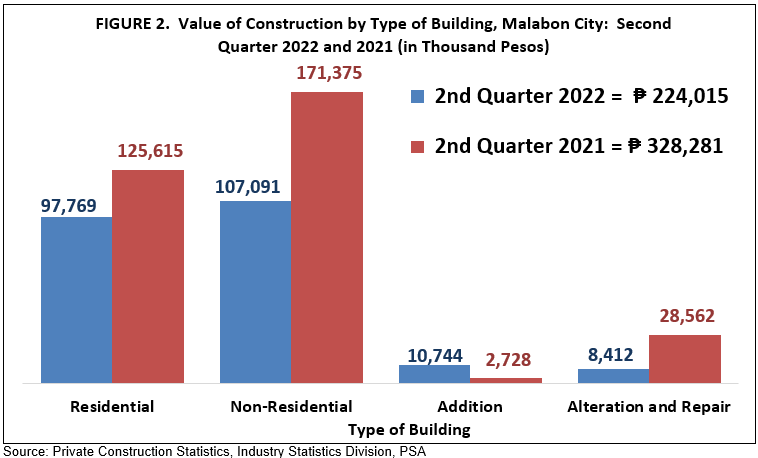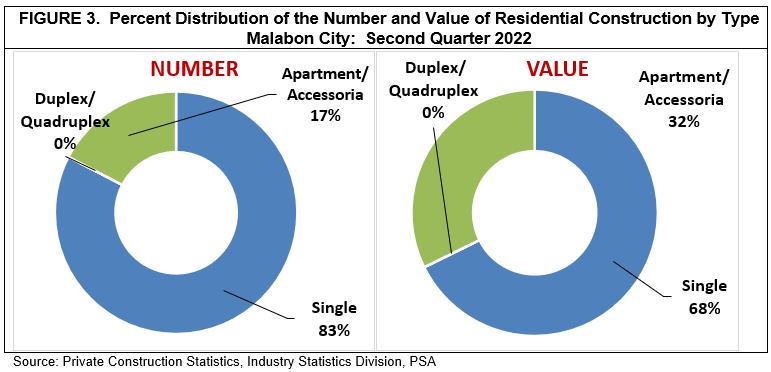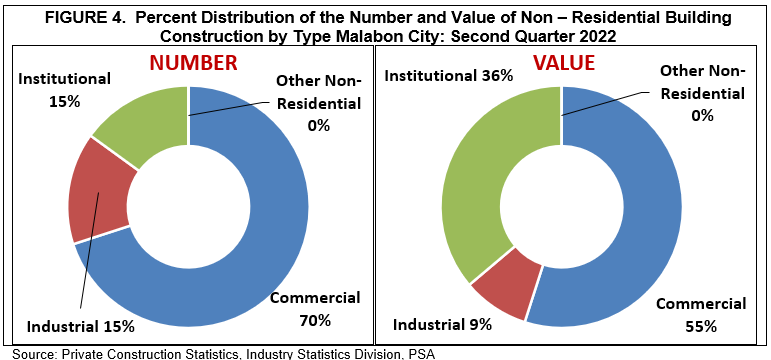This special release presents data on construction statistics from approved building permits of Malabon City for the second quarter of 2022. Figures are based on the preliminary results of the tabulated data from collected approved building permits.
Number of Building Permit remains the same in 2022
The total number of approved building permits in the City of Malabon was recorded at 110 during the 2nd Quarter of 2022. The same number was observed in the same quarter of 2021. However, total value of construction projects during the 2nd quarter of 2022 went down by 31.76 percent to ₱ 224,015 thousand from ₱ 328,281 thousand of the same quarter in 2021.
Across the region, Malabon City contributed 4.32 percent to the total number of approved building permits and 1.04 percent to the total value of construction projects during the second quarter of 2022 while within the National Capital Region Provincial Office IV- CAMANAVA, the city of Malabon contributed 12.28 percent to the number of approved building permits and 10.17 percent to the total value of construction during the second quarter of 2022. (Table 1.)
Table 1. Number, Floor Area and Value of Building Construction of Malabon City: Second Quarter 2022
| City | 2nd Quarter 2022P | 2nd Quarter 2021 | ||||
| Number | Floor Area (sq. m.) | Value (₱1,000) | Number | Floor Area (sq. m.) | Value (₱1,000) | |
| (1) | (2) | (3) | (4) | (5) | (6) | (7) |
| Philippines | 41,514 | 8,927,913 | 103,576,879 | 42,360 | 7,839,263 | 92,255,553 |
| National Capital Region (NCR) | 2,545 | 1,255,157 | 21,475,642 | 2,510 | 1,201,910 | 17,685,291 |
| NCR PO IV | 896 | 269,037 | 2,203,754 | 902 | 268,956 | 2,268,938 |
| MALABON CITY | 110 | 29,296 | 224,015 | 110 | 35,995 | 328,281 |
Source: Private Construction Statistics, Industry Statistics Division, PSA
Number of Residential Construction Decreases
Residential constructions slightly went down by 2.82 percent to 69 from 71 reported during the same period of 2021. Alterations and repair with 13 projects also went down by 23.53 percent compared to 17 projects during the same period of 2021. On the other hand, Additions to existing structures during the 2nd quarter of 2022 showed an increase of 300 percent to 8 from 2 in the same quarter of 2021. Meanwhile, non-residential constructions remain the same at 20 construction projects in the second quarter last year. (Fig.1)
Figure1 shows the comparison in the number of approved building permits by type of building in the city of Malabon during the second quarter of 2022 and 2021.

Value for Residential Building Construction Decreases
The value of construction for residential buildings estimated at ₱ 97,769 thousand decreased by 22.17 percent from ₱ 125,615 thousand recorded during the same period of last year. Likewise, value of non-residential construction decreased by 37.51 percent to ₱ 107,091 thousand from ₱ 171,375 thousand during the same period of 2021. Alterations and repairs amounting to ₱ 8,412 thousand also decreased by 70.55 percent from ₱ 28,562 thousand reported in the same period of 2021. During the second quarter of 2022 value of additions to existing structures however increased by 293.84 percent to ₱ 10,744 thousand from ₱ 2,728 thousand posted on the same quarter in 2021. (Fig.2)
Figure 2 shows the comparison in the value of approved building permits by type of building in Malabon City during the Second Quarter of 2022.

Single Type of Residential Building Dominated All Other Types of Residential Building Constructions
Among residential constructions, single type recorded the greatest number of projects with 57 representing 83.0 percent of the total. Total value of construction for this type amounted to ₱ 66,193 thousand has the greatest share of 68.0 percent to the gross value of ₱ 97,769 thousand. (Fig.3 and Table 2)

Commercial Type of Building Registers the Highest Among Non-Residential Building Constructions
Among the non-residential building constructions, commercial type dominated all other types of non-residential constructions with 14 projects or 70.0 percent of the total. Construction value of this type amounted to ₱ 58,839 thousand or 55.0 percent share of the total value. Institutional buildings ranked second with 3 project or 15.0 percent of the total with construction value amounted to ₱ 38,728 thousand. Followed by Industrial construction also with 3 projects and construction value of ₱ 9,523 thousand or 9 percent share of the total value. Meanwhile, Other non-residential construction was without project for the 2nd quarter of 2022. (Fig.4 and Table 2)

Table 2. Number, Floor Area, Value and Average Cost per Floor Area of Building Construction by Type, Malabon City: Second Quarter 2022 and 2021
| Type of building | 2nd Quarter 2022p | 2nd Quarter 2021 | ||||||
| Number | Floor Area | Value | Average Cost per Floor area | Number | Floor Area | Value | Average Cost per Floor area | |
| (Sq. m) | (₱1,000) | (Sq. m) | (₱1,000) | |||||
| (1) | (2) | (3) | (4) | (5) | (6) | (7) | (8) | (9) |
| Total | 110 | 29,296 | 224,015 | 7.65 | 110 | 35,995 | 328,281 | 9.12 |
| Residential | 69 | 11,490 | 97,769 | 8.51 | 71 | 14,136 | 125,615 | 8.89 |
| Single | 57 | 7,858 | 66,193 | 8.42 | 65 | 11,738 | 103,681 | 8.32 |
Duplex/ Quadruplex | - | - | - | - | - | - | - | - |
Apartment and Accesoria | 12 | 3,632 | 31,575 | 8.69 | 6 | 2,398 | 21,934 | 9.15 |
Other Residential | - | - | - | - | - | - | - | - |
| Non-Residential | 20 | 16,382 | 107,091 | 6.54 | 20 | 21,263 | 171,375 | 8.06 |
| Commercial | 14 | 9,443 | 58,839 | 6.23 | 14 | 7,842 | 56,633 | 7.22 |
| Industrial | 3 | 1,370 | 9,523 | 6.95 | 3 | 5,401 | 26,991 | 4.99 |
| Institutional | 3 | 5,569 | 38,728 | 6.95 | 3 | 8,020 | 87,752 | 10.94 |
Other Non- Residential | - | - | - | - | - | - | - | - |
| Addition | 8 | 1,424 | 10,744 | 7.54 | 2 | 596 | 2,728 | 4.58 |
| Alteration and Repair | 13 | 8,412 | - | 17 | 28,562 | - | ||
Source: Private Construction Statistics, Industry Statistics Division, PSA
Explanatory Notes
Scope and Coverage
Private construction statistics from approved building permits relate to new constructions and additions, alterations and repairs of existing residential and non-residential buildings and other structures undertaken in all regions/provinces of the country. Presented in this special release were data from the city of Malabon.
Source of Information
Data are taken from the original applications of approved building permits collected by PSA field personnel from the Offices of Local Building Officials.
Limitations:
1. Data on private building constructions refer to those proposed to be constructed during the reference period and not to construction work completed during the reference period.
2. The completeness of the number of building permits collected relies on the approval of applications filed with the Office of Local Building Officials (LBOs). Hence, private building constructions without approved building permits are excluded in the tabulation of data.
Definition of Terms:
Building Permit-A written authorization granted by the Local Building Official (LBO) to an applicant allowing him to proceed with the construction of a specific project after plans, specifications and other pertinent documents have been found to be in conformity with the National Building Code (PD 1096).
Building-Any independent, freestanding structure comprised of one or more rooms or other spaces, covered by a roof and enclosed with external walls or dividing walls, which extend from the foundation to the roof.
Construction-All on-site work done from site preparation, excavation, foundation, assembly of all the components and installation of utilities and equipment of buildings/structures.
Residential Building-A building for which its major parts or more than half of its gross floor area is built for dwelling purposes. This type of building can be of the single type, duplex, an apartment and/or accessoria and residential condominium.
Single House-A complete structure intended for a single family or household, i.e. bungalow, 2-storey house, nipa hut.
Duplex-A structure intended for two households, with complete living facilities for each; it is a single structure divided into two dwelling units by a wall extending from the floor to the ceiling.
Apartment-A structure, usually of two storeys, made up of independent living quarters, with independent entrances from internal walls and courts.
Accessoria-A one or two-floor structure divided into several dwelling units, each dwelling unit having its own separate entrance from the outside.
Residential Condominium-A structure, usually of several storeys, consisting of multiple dwelling units.
Other residential constructions-Consist of school or company staff houses, living quarters for drivers and maids and guardhouses.
Non-Residential Building-This type includes commercial, industrial, agricultural and institutional buildings.
Commercial Buildings-Office buildings and all buildings that are intended for use primarily in wholesale, retail and service trades; i.e., stores, hotels, restaurants, banks, disco houses, etc.
Industrial Buildings-All buildings which are used to house the production, assembly and warehousing activities of industrial establishments; i.e., factories, plants, mills, repair shops, machine shops, printing press, storage plant, electric generating plants.
Institutional Buildings - All buildings that are primarily engaged in providing educational instructions and hospital/health care; ports, airports and other government buildings; i.e., school, museums, libraries, sanitaria, churches, hospitals.
Agricultural Buildings - All buildings, which are used to house live stocks, plants and agricultural products such as barn, poultry house, piggeries, stables, greenhouses and grain mill.
Other Non-Buildings Constructions - These include cemetery structures, street furniture, waiting sheds, communication towers, etc.
Addition - Any new construction that increases the height or area of an existing building/structure.
Alteration - Construction in a building/structure involving changes in the materials used, partitioning, location/size of openings, structural parts, existing utilities and equipment but does not increase the overall area thereof.
Repair – A remedial work done on any damaged or deteriorated portion/s of a building/structure to restore its original condition.
Demolitions - The systematic dismantling or destruction of a building/structure or in part.
Street Furniture - These are street structures consisting of monuments, waiting sheds, benches, plant boxes, lampposts, electric poles and telephone poles.
Floor Area of Building - The sum of the area of each floor of the building measured to the outer surface of the outer walls including the area of lobbies, cellars, elevator shafts and all communal spaces in multi-dwellings. Areas of balconies are excluded.
Total Value of Construction - The sum of the cost of building, electrical, mechanical, plumbing and others. The value is derived from the approved building permit and represents the estimated value of the building or structure when completed.
BELEN R. RAZO
Chief Statistical Specialist
PSA NCR IV- (CAMANAVA)
